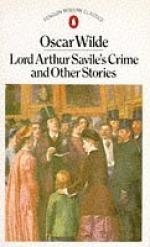|
This section contains 6,292 words (approx. 21 pages at 300 words per page) |

|
SOURCE: Wilburn, Lydia Reineck. “Oscar Wilde's ‘The Canterville Ghost’: The Power of an Audience.” Papers on Language and Literature 23, no. 1 (winter 1987): 41-55.
In the following essay, Wilburn contends that Wilde utilized his stories, particularly “The Canterville Ghost,” to “work through problems involving the audience's power over different phases of the artist's performance.”
Although Wilde's short story collection Lord Arthur Savile's Crime and Other Stories has enjoyed some critical attention, most of the discussion has focused on the comic and moral content of the stories, especially the relationship between the criminal and the artist.1 But a closer examination of the stories suggests that Wilde was also exploring various concepts of a theory of performance—specifically the artist's and audience's roles in the artistic performance. Wilde was using the texts, particularly “The Canterville Ghost,” to work through problems involving the audience's power over different phases of the artist's performance.
In...
|
This section contains 6,292 words (approx. 21 pages at 300 words per page) |

|


